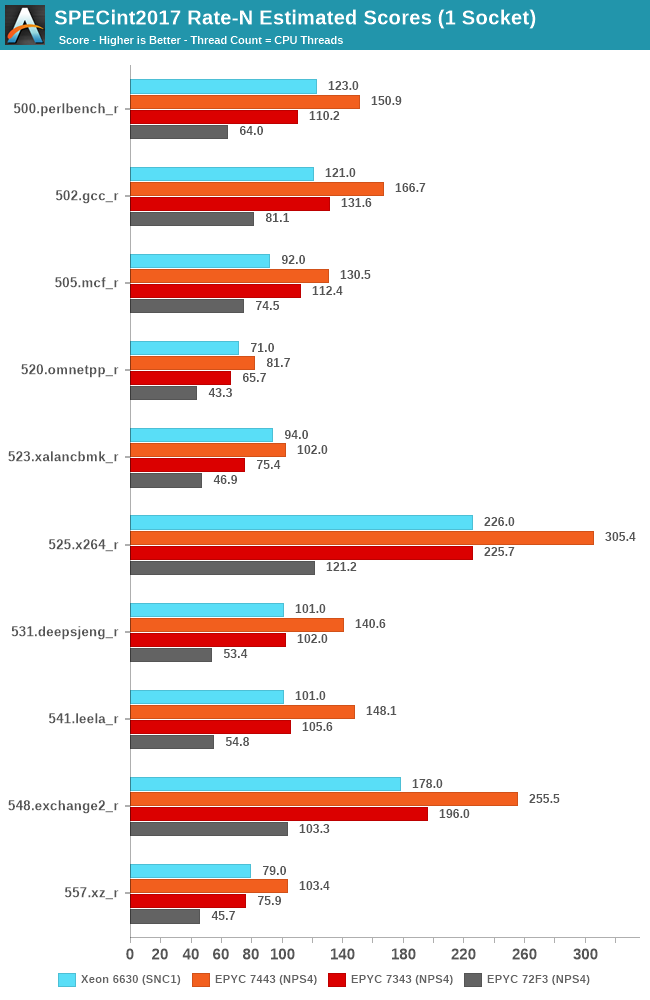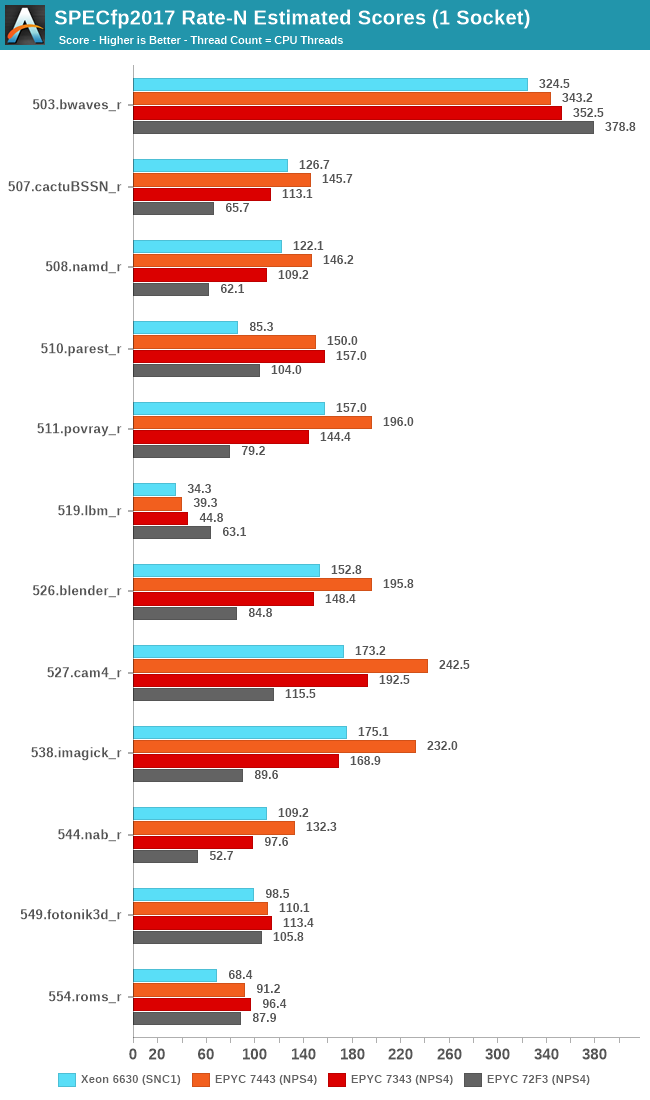AMD EPYC Milan Review Part 2: Testing 8 to 64 Cores in a Production Platform
by Andrei Frumusanu on June 25, 2021 9:30 AM ESTSPEC - Multi-Threaded Performance - Subscores
Picking up from the power efficiency discussion, let’s dive directly into the multi-threaded SPEC results. As usual, because these are not officially submitted scores to SPEC, we’re labelling the results as “estimates” as per the SPEC rules and license.
We compile the binaries with GCC 10.2 on their respective platforms, with simple -Ofast optimisation flags and relevant architecture and machine tuning flags (-march/-mtune=Neoverse-n1 ; -march/-mtune=skylake-avx512 ; -march/-mtune=znver2 (for Zen3 as well due to GCC 10.2 not having znver3).
I’ll be going over two chart comparisons, first of all, with the respective flagship parts, consisting of the new EPYC 7763 numbers, pitted against Intel’s 40-core Xeon Ice Lake SP and Ampere’s Altra Q80-33, along with the figures we have on AMD’s EPYC 7742. It’s to be noted that this latter is a 225W part, compared to the 280W 7763.

In SPECint2017, the EPYC 7763 extends its lead over Intel’s current best CPU, improving the numbers beyond what we had originally published in our April review. While AMD also further narrows the gap to Ampere’s 80-core Altra SKU, there are still many core-bound workloads that still notably favour the Neoverse N1 part given its 25% advantage in core count.

Also in SPECint2017, but this time focusing on the mid-tier SKUs, the main comparison points that are interesting here is the new 24-core EPYC 7443 and 16-core EPYC 7343 against the new 28-core Xeon 6330. What’s shocking here, is that Intel’s new Ice Lake SP server chip has troubles not only competing against AMD’s 24-core chip, but actually even struggles to differentiate itself from AMD’s 16-core chip, which is quite shocking.
The 72F3 8-core part is interesting, but generally we have troubles to competitively place such a SKU given that we don’t have a comparable part from the competition to pit against it.

For the high-end SKUs, we again see the 7763 increase its performance positioning compared to what we had review a few months ago, although with fewer large performance boost outliers, due o the memory-heavy nature of the floating-point test suite.

In the low-end SKUs, we see a similar story as in the integer suite, where AMD’s 16-core 7343 battles it out against Intel’s 28-core Xeon, while the 24-core unit is comfortable a good margin ahead of the competition.
The 72F3 showcases some interesting score here – because there’s more workloads that are fundamentally memory bound; the actual core count deficit of this SKU doesn’t really hamper its performance compared to its siblings. If anything, the lower core count actually has some positive side-effects as it results in less cache and DRAM contention, resulting in less overhead and actually higher performance than the higher core count parts. Theoretically you could mimic this with the higher core count parts by simply running fewer workload instances and threads, but if a system deployment would be running workloads that are more typical of such performance characteristics, the low-core count 72F3 could make sense.










58 Comments
View All Comments
mode_13h - Sunday, June 27, 2021 - link
Thanks for this update. Exciting findings!Gondalf - Sunday, June 27, 2021 - link
SPECint2017 is good but....SPECint2017 Rate to estimate the per-core performance, no no absolutely no. SPECint2017 Rate have a very small dataset and it can not be utilized to estimate the single core performance, we need of the full SPECint2017 workload, the only manner to bypass the crazy L3 of Ryzen. Half the article have a so so sense ( obviously SPEC Rate is very criticized by many and very likely means less than nothing, expeciallly if you rise the bar on L3 ), the other half nope, without sense.In fact Intel claim a new 10nm 32 cores superior than a 32 cores Milan, after all the two cores ( Zen 3 and Willow Cove) have around the same IPC, more or less, and being chiplets, 32 cores Milan is out of the games.
Obviously in this article the world "latency" is hidden or so. A single die solution is always better than chiplet design under load with the same number of cores.
Qasar - Sunday, June 27, 2021 - link
and there is the highly biased anti amd post from gondalf that he is known for." In fact Intel claim a new 10nm 32 cores superior than a 32 cores Milan, after all the two cores ( Zen 3 and Willow Cove) have around the same IPC, more or less, and being chiplets, 32 cores Milan is out of the games. "
yea ok, more pr bs from intel that you blindly believe ? post a link to this. the fact that you start with " in fact intel claim" kind of point to it being bs.
schujj07 - Monday, June 28, 2021 - link
Gandalf missed a link I posed that has a 32c Intel vs 32c AMD. In that the AMD averages 20% better performance than the Intel across the entire test suite. https://www.servethehome.com/intel-xeon-gold-6314u...iAPX - Sunday, June 27, 2021 - link
There's a lot to read and understand on the last chart (per-Thread score / Socket Perf), about usefulness of SMT (or not), about who is the per-Thread performance leader and also the per-Socket performance leader, with a notable exception, the Altra Q80-33.I would like to see these kind of chart more often, it sum-up things very clearly, while naturally you have to understand that it is just a long-story short, and have to read about specific performance depending on the payload (ie: DB as stated).
Kudos!
nordform - Thursday, July 1, 2021 - link
Too bad Apple's M1 was left out ... it clearly would have smoked the "competition". Everything with a TDP higher than 25W is inappropriate, not to say obscene.Apple rules hands down
Qasar - Friday, July 2, 2021 - link
" Everything with a TDP higher than 25W is inappropriate, not to say obscene. " and why would that be ?mode_13h - Friday, July 2, 2021 - link
That would be like drag racing a Tesla car against some 18-wheeled diesel trucks.Server CPUs are not optimized for low-thread performance. They're designed to scale, and have data fabrics to handle massive amounts of I/O that the M1 can't. It wouldn't be a fair (or relevant) comparison.
Now, try running that Tesla car in a tractor pull and we'll see who's laughing!
Oxford Guy - Thursday, July 8, 2021 - link
Happy to have won another debate in which my suggestion was aggressively attacked.I said having dual channel DDR4 for Zen 3 was unfortunate, as DDR4 is so long in the tooth — a fact that dual channel configuration makes more salient. I said it would have been good for the company to add more value by giving it quad channel RAM or, if possible, a support for both DDR4 and DDR5 — something some mainstream Intel quads had (support for DDR3 and DDR4).
My remark was derided mainly on the basis of the claim that dual channel is plenty. This new set of parts demonstrate the benefit of having more RAM and cache.
Considering how high the core counts are for Zen 3 desktop CPUs and how much Apple has set people on notice about what’s possible in CPU performance...
Also, part of the rebuttal was citing the existence of TR. That’s still Zen 2, eh? Can’t really go out and buy that rebuttal.
Is the benefit of being able to stay with the AM4 socket bigger than having less starvation of the CPU, particularly given the very high core counts of CPUs like the 5950? TR may be everyone’s segmentation dream (particularly when it’s being laughingly sold with obsolete Zen 2 and subjected to rapid expensive motherboard orphaning) but I think having five motherboard specs is a bridge too far. Let the low-end have dual channel and no overclocking, dump TR, and consolidate the enthusiast boards to a single (not two) chipset. But... that’s me. I like more value versus little crumbs and redundancies. When a whopping two companies is the state of the competition, though, people become trained to celebrate banality.
mode_13h - Thursday, July 8, 2021 - link
> Zen 3 was unfortunate, as DDR4 is so long in the tooth ...> it would have been good for the company to add more value by giving it quad channel RAM
Agreed. Would've been nice. In spite of that, the 5950X manages to show gains over the 5900X, but we can still wonder how much better it might be with more memory bandwidth.
I wouldn't have an issue with quad-channel being reserved for their TR platform if:
* they were more affordable
* they brought Zen3 to the platform more promptly
An interesting counter-point to consider is how little 8-channel RAM benefitted TR Pro:
"In the tests that matter, most noticeably the 3D rendering tests, we’re seeing a 3% speed-up on the Threadripper Pro compared to the regular Threadripper at the same memory frequency and sub-timings."
https://www.anandtech.com/show/16478/64-cores-of-r...
That's much less benefit than I'd have expected, as a 64-core TR on quad-channel should be far more bandwidth-starved than a 16-core Ryzen on dual-channel. However, that same article features a micro-benchmark which shows the full potential of 8-channel. So, it's obviously workload-dependent.